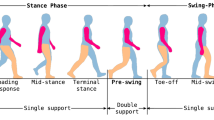Abstract
Virtual reality technology shows serious potential in many fields, such as cinemtic entertainment, professional training, Healthcare and clinical therapies, etc. In this paper, we propose a novel human balance capability evaluation method, which is based on crossing bridge virtual scene and video analysis. We have sampled the crossing bridge movement video of two groups of volunteers with balance ability differences, and then we proposed a balance ability classification algorithm via barycentric shifts model statistical analysis. The small sample experiment shows that our method can accurately identify the possible candidates with balance ability abnormality.
Access this chapter
Tax calculation will be finalised at checkout
Purchases are for personal use only
Similar content being viewed by others
References
Ustinova, K.I., Leonard, W.A., Cassavaugh, N.D., et al.: Development of a 3D immersive videogame to improve arm-postural coordination in patients with TBI. J. Neuroeng. Rehabil. 8(1), 1–11 (2011)
Rubin, M.A.: Make precision medicine work for cancer care: to get targeted treatments to more cancer patients pair genomic data with clinical data, and make the information widely accessible. Nature 520(7547), 290–292 (2015)
Yin, C., Hsueh, Y.H., Yeh, C.Y., et al.: A virtual reality-cycling training system for lower limb balance improvement. Biomed. Res. Int. 2016(1), 1–10 (2016)
Liau, B.-Y., Lung, C.-W., Jan, Y.-K.: Development of human balance assessment system with continuous center of gravity tracking. In: Duffy, V.G. (ed.) DHM 2013. LNCS, vol. 8025, pp. 332–337. Springer, Heidelberg (2013). https://doi.org/10.1007/978-3-642-39173-6_39
Lafond, D., Duarte, M.F.: Comparison of three methods to estimate the center of mass during balance assessment. J. Biomech. 37(9), 1421–1426 (2004)
Moraru, C., Neculaeş, M., Hodorcă, R.M.: Comparative study on the balance ability in sporty and unsporty children. Procedia - Soc. Behav. Sci. 116, 3659–3663 (2014)
Lloréns, R., Gilgómez, J.A., Alcañiz, M., et al.: Improvement in balance using a virtual reality-based stepping exercise: a randomized controlled trial involving individuals with chronic stroke. Clin. Rehabil. 29(3), 261–268 (2015)
Ferdous, S.M.S.: Improve accessibility of virtual and augmented reality for people with balance impairments. In: 2017 IEEE Virtual Reality, pp. 421–422 (2017)
Zhang, B.F., Zhou, J., Zhu, J.C.: Research on three image difference algorithm. In: International Conference on Image Analysis and Signal Processing, pp. 603–606. IEEE (2010)
Palaniappan, S.: Image denoising using median filter with edge detection using canny operator. Int. J. Sci. Res. 3(2), 30–34 (2014)
Lin, C.Y., Chai, H.C., Wang, J.Y., et al.: Augmented reality in educational activities for children with disabilities. Displays 42, 51–54 (2015)
Lakhani, B., Mansfield, A.: Visual feedback of the centre of gravity to optimize standing balance. Gait Posture 41(2), 499–503 (2015)
Tarabalka, Y., Fauvel, M., Chanussot, J., et al.: SVM- and MRF-based method for accurate classification of hyperspectral images. IEEE Geosci. Remote Sens. Lett. 7(4), 736–740 (2010)
Ayyaz, M.N., Javed, I., Mahmood, W.: Handwritten character recognition using multiclass SVM classification with hybrid feature extraction. Pak. J. Eng. Appl. Sci. 10, 57–67 (2016)
Acknowledgment
This work is supported in part by the National Natural Science Foundation of China under grant Nos. 61472204, 6150238.
Author information
Authors and Affiliations
Corresponding author
Editor information
Editors and Affiliations
Rights and permissions
Copyright information
© 2019 Springer Nature Switzerland AG
About this paper
Cite this paper
Jin, H., Lin, W., Xiao, Z., Liu, H., Wang, B., Li, X. (2019). Barycentric Shift Model Based VR Application for Detection and Classification on Body Balance Disorders. In: El Rhalibi, A., Pan, Z., Jin, H., Ding, D., Navarro-Newball, A., Wang, Y. (eds) E-Learning and Games. Edutainment 2018. Lecture Notes in Computer Science(), vol 11462. Springer, Cham. https://doi.org/10.1007/978-3-030-23712-7_1
Download citation
DOI: https://doi.org/10.1007/978-3-030-23712-7_1
Published:
Publisher Name: Springer, Cham
Print ISBN: 978-3-030-23711-0
Online ISBN: 978-3-030-23712-7
eBook Packages: Computer ScienceComputer Science (R0)




